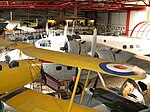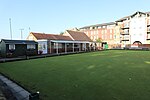History of the Port of Southampton
EngvarB from September 2013History of SouthamptonPort of Southampton

The Port of Southampton is a major passenger and cargo port located in the central part of the south coast of England. It has been an important port since the Roman occupation of Britain nearly two thousand years ago, and has a multifaceted history. From the Middle Ages to the end of the 20th century, it was a centre for naval shipbuilding and a departure point for soldiers going to war. The port also played a role in the development of hovercraft, flying boat services, seaplanes and the Spitfire fighter plane. Before the advent of jet travel, Southampton was Britain's gateway to the world. The port also played a minor role in the history of Britain's canals.
Excerpt from the Wikipedia article History of the Port of Southampton (License: CC BY-SA 3.0, Authors, Images).History of the Port of Southampton
Old Road, Southampton St Mary's
Geographical coordinates (GPS) Address Nearby Places Show on map
Geographical coordinates (GPS)
| Latitude | Longitude |
|---|---|
| N 50.8965 ° | E -1.3968 ° |
Address
Old Road
Old Road
SO14 3AE Southampton, St Mary's
England, United Kingdom
Open on Google Maps








